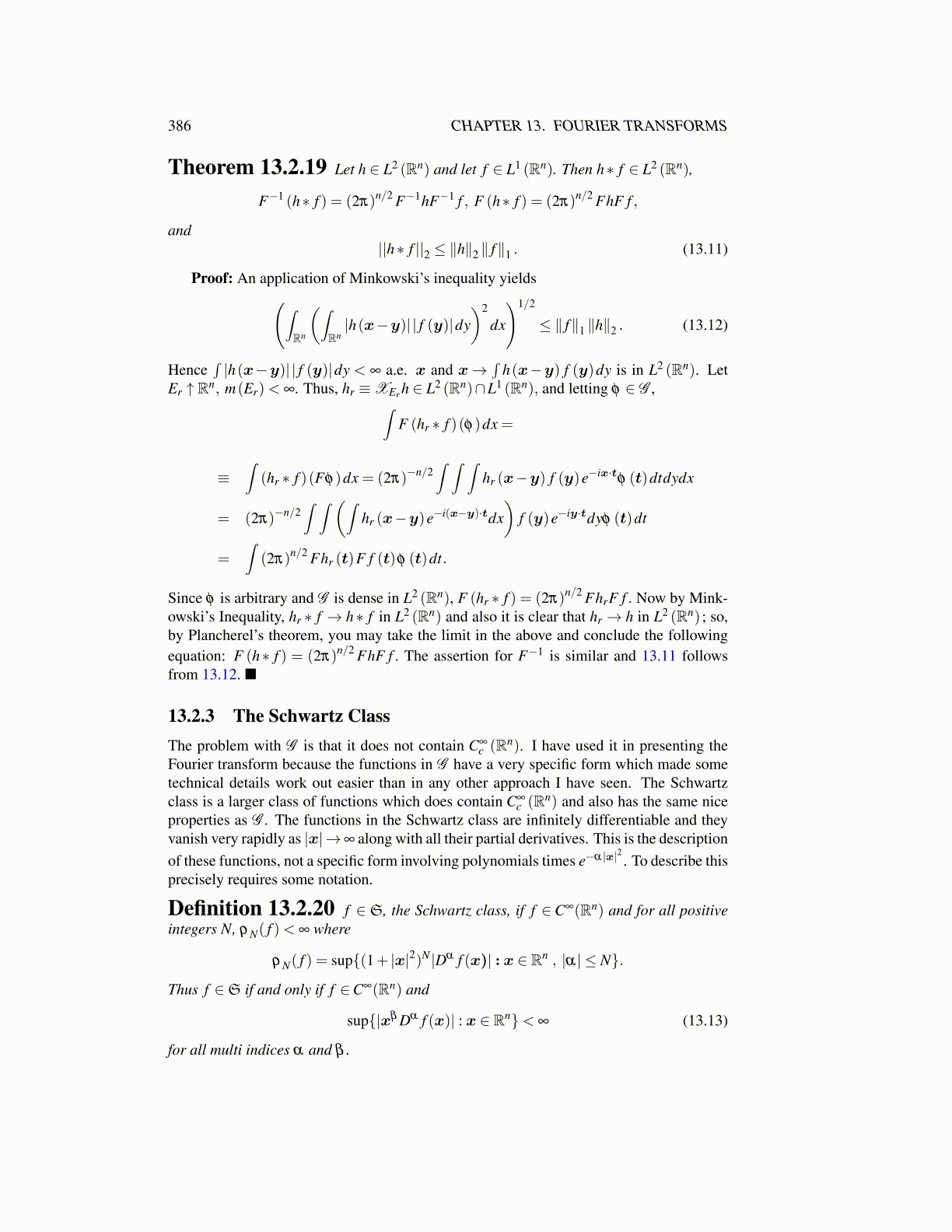
386 CHAPTER 13. FOURIER TRANSFORMS
Theorem 13.2.19 Let h ∈ L2 (Rn) and let f ∈ L1 (Rn). Then h∗ f ∈ L2 (Rn),
F−1 (h∗ f ) = (2π)n/2 F−1hF−1 f , F (h∗ f ) = (2π)n/2 FhF f ,
and||h∗ f ||2 ≤ ∥h∥2 ∥ f∥1 . (13.11)
Proof: An application of Minkowski’s inequality yields(∫Rn
(∫Rn|h(x−y)| | f (y)|dy
)2
dx
)1/2
≤ ∥ f∥1 ∥h∥2 . (13.12)
Hence∫|h(x−y)| | f (y)|dy < ∞ a.e. x and x→
∫h(x−y) f (y)dy is in L2 (Rn). Let
Er ↑ Rn, m(Er)< ∞. Thus, hr ≡XEr h ∈ L2 (Rn)∩L1 (Rn), and letting φ ∈ G ,∫F (hr ∗ f )(φ)dx =
≡∫
(hr ∗ f )(Fφ)dx = (2π)−n/2∫ ∫ ∫
hr (x−y) f (y)e−ix·tφ (t)dtdydx
= (2π)−n/2∫ ∫ (∫
hr (x−y)e−i(x−y)·tdx)
f (y)e−iy·tdyφ (t)dt
=∫
(2π)n/2 Fhr (t)F f (t)φ (t)dt.
Since φ is arbitrary and G is dense in L2 (Rn), F (hr ∗ f ) = (2π)n/2 FhrF f . Now by Mink-owski’s Inequality, hr ∗ f → h∗ f in L2 (Rn) and also it is clear that hr → h in L2 (Rn) ; so,by Plancherel’s theorem, you may take the limit in the above and conclude the followingequation: F (h∗ f ) = (2π)n/2 FhF f . The assertion for F−1 is similar and 13.11 followsfrom 13.12. ■
13.2.3 The Schwartz ClassThe problem with G is that it does not contain C∞
c (Rn). I have used it in presenting theFourier transform because the functions in G have a very specific form which made sometechnical details work out easier than in any other approach I have seen. The Schwartzclass is a larger class of functions which does contain C∞
c (Rn) and also has the same niceproperties as G . The functions in the Schwartz class are infinitely differentiable and theyvanish very rapidly as |x|→∞ along with all their partial derivatives. This is the descriptionof these functions, not a specific form involving polynomials times e−α|x|2 . To describe thisprecisely requires some notation.
Definition 13.2.20 f ∈S, the Schwartz class, if f ∈C∞(Rn) and for all positiveintegers N, ρN( f )< ∞ where
ρN( f ) = sup{(1+ |x|2)N |Dα f (x)| : x ∈ Rn , |α| ≤ N}.
Thus f ∈S if and only if f ∈C∞(Rn) and
sup{|xβ Dα f (x)| : x ∈ Rn}< ∞ (13.13)
for all multi indices α and β .